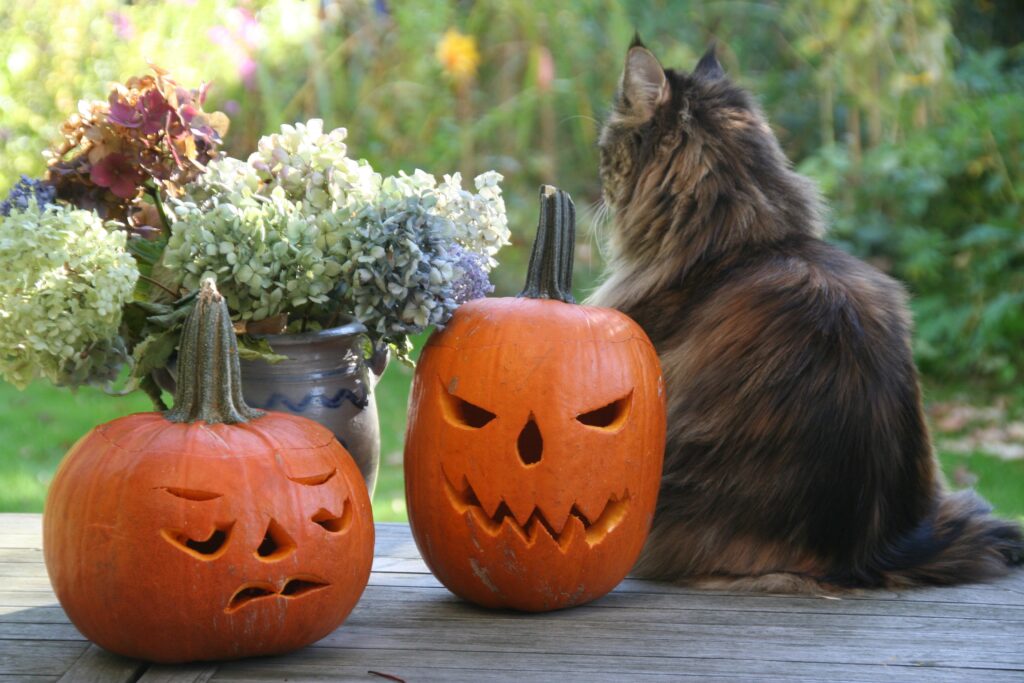
What is great fun for us is not always so fun for our pets. Halloween is second only to 4th of July on numbers of animals that end up in shelters, making it an excellent time to make sure your contact information is up to date on microchip registries and legible on ID tags. Both with greatly increase the chances of your pet making it back to you should they become lost. Costumes and loud animals can make the familiar world suddenly scary to many animals and many sweet treats can be potentially fatal to dogs and cats.
It can be a good idea to walk dogs before it gets dark, so they can be back inside before all the ghosts, ghouls, and (gasp!)princesses come out to haunt the streets. Likewise it is wise for your pets to stay home if you plan to go out ringing doorbells. Many dogs get scared by costumes and loud noises and can become aggressive or suddenly dart into a busy street. If you stay at home, supervise your pets closely or give them their own space in a quieter room of the house when Trick or Treaters come knocking.
October has become popular for dressing up our pets too, but unless your pet is truly comfortable in a costume, keep it clothing optional…for the pet! Something simple like a bandana could be appropriate to dress up your pet without causing them distress. Most pets don’t like masks that cover their eyes or loose fabric that is tricky to walk in. If you do feel your 4 legged friend would be willing to dress up, here are a few tips: Do some practice sessions with lots of rewards, starting with parts of the costume for short periods to acclimate your pet to his costume and make it a positive experience. Be sure to do the same with your costume giving your pet time to recognize that is you in there. Make sure their costume is not adorned with beads or strings which could be swallowed and be sure any elastic bands holding the costume in place are not to tight and restricting blood flow. Also make sure your pet can still answer nature’s call comfortably and nothing causes difficulty with vision. Finally, never leave them unsupervised in a costume.
Lots of pets love treats too. There are lots of ways to make sure your pet has as yummy a Halloween as you! Here are some ways to avoid cat-astrophies and doggy dangers. Pups anxious for a sweet treat rarely take time to unwrap them. Paper, cellophane, and foil candy wrappers can clog the intestines making for a truly scary situation. Chocolate contains Theobromine which is both a cardiac stimulant and diuretic. This will speed up your pet’s heart rate and respiration and pull fluids from his body which can result in seizures and death. Beware of grapes or raisins masquerading as “eyeballs”. These can cause kidney failure in dogs. Make sure pets can’t get a hold of plastic toothpicks in both festive cupcakes and adult beverages.
Cooked pumpkin can be a great treat, however once it becomes a Jack-o-lantern, it can cause more harm than good. Candles placed inside can burn precious snouts and paws, or if turned over start fires. Be sure to keep pumpkins, candles, and electric cords inaccessible or uninviting to chew. Fake spider webs and spray string can be toxic or cause choking.
Talk to your veterinarian ahead of time if you have a particularly anxious pet who could benefit from calming aid or medication. A tired dog or cat is generally a happy dog or cat, so don’t forget lots of exercise and playtime before festivities start, but then let your fur babies retreat to a quiet place with pet safe treats and toys when the zombies come to call.
